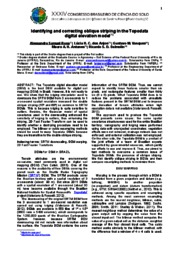Identifying and correcting oblique striping in the topodata digital elevation model.
Identifying and correcting oblique striping in the topodata digital elevation model.
Author(s): SAMUEL-ROSA, A.; ANJOS, L. H. C. dos; VASQUES, G. de M.; ANTUNES, M. A. H.; DALMOLIN, R. S. D.
Summary: The Topodata digital elevation model (DEM) is the best DEM available for digital soil mapping (DSM) in Brazil. However, it is not ready to use. We show that the kriging interpolator used to downscale the SRTM DEM from 3 arc-seconds to 1 arc-second spatial resolution increased the double oblique striping (15º and 60º) so common to SRTM DEMs. This is because kriging is quite sensitive to outliers. Besides, the Gaussian model of spatial covariance used in the downscaling enhanced the sensitivity of kriging to outliers, thus enhancing the striping. 2D Fast Fourier Transform can be used to identify whether a destriping procedure need to be employed. The bilinear or cubic resampling methods should be used to warp Topodata DEMs because they are insensitive to the double oblique striping.
Publication year: 2013
Types of publication: Paper in annals and proceedings
Unit: Embrapa Soils
Keywords: 2D Fast Fourier Transform, DEM warping, SRTM downscaling
Observation
Some of Embrapa's publications are published as ePub files. To read them, use or download one of the following free software options to your computer or mobile device. Android: Google Play Books; IOS: iBooks; Windows and Linux: Calibre.
Access other publications
Access the Agricultural Research Database (BDPA) to consult Embrapa's full library collection and records.
Visit Embrapa Bookstore to purchase books and other publications sold by Embrapa.

